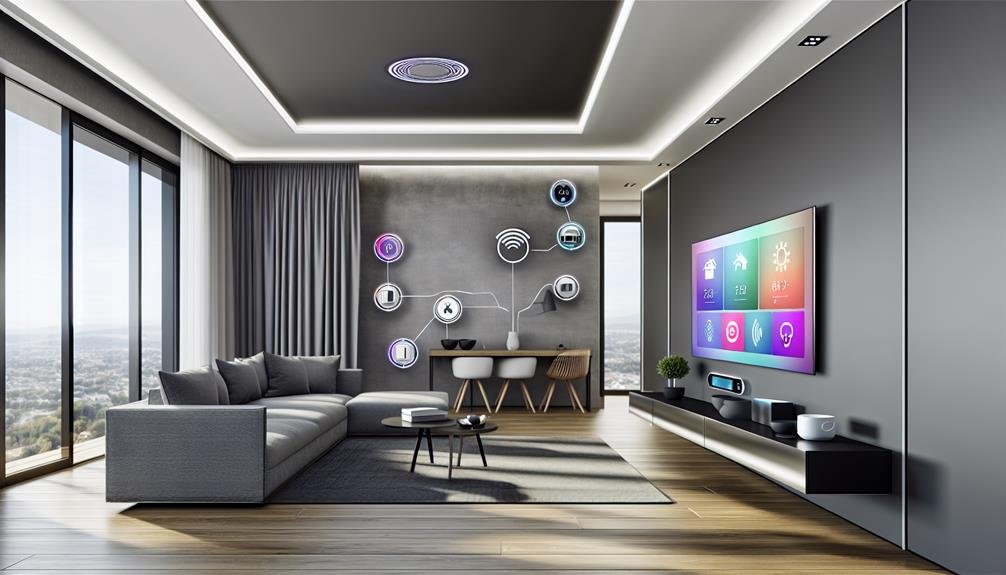Did you know that the average American household has 25 smart devices?
With the increasing popularity of smart home automation, it's no wonder that managing multiple devices and systems can become overwhelming.
But fear not, because in this discussion, we will explore some effective strategies for streamlining and simplifying the management of your smart home.
From choosing the right smart home hub to setting up customized scenes and automations, we will provide you with practical tips and insights to make your smart home experience more convenient and enjoyable.
So, get ready to take control of your smart home and discover how to effortlessly manage all your devices and systems.
Key Takeaways
- Choosing the right smart home hub is essential, considering specific needs and compatibility requirements.
- Creating a centralized control system by connecting all smart devices to a central hub simplifies control and allows for remote access from anywhere.
- Organizing and grouping devices by room and functionality enhances the overall performance of the smart home automation system.
- Setting up customized scenes and automations based on specific needs and preferences, along with monitoring and troubleshooting smart devices, optimize energy consumption and ensure correct functioning.
Choosing the Right Smart Home Hub
When choosing the right smart home hub, it's important to consider your specific needs and compatibility requirements. Comparing different smart home hub options is crucial to find the one that suits you best. There are various smart home hubs available in the market, each with its own set of features and capabilities. Some popular options include Amazon Echo, Google Home, and Apple HomePod.
One key consideration when choosing a smart home hub is the ability to integrate voice control. Voice control allows you to control your smart devices and systems using simple voice commands. It adds convenience and ease of use to your smart home automation setup. Most smart home hubs support voice control and are compatible with popular voice assistants such as Amazon Alexa, Google Assistant, and Apple Siri.
Before making a decision, it's important to ensure that the smart home hub you choose is compatible with your existing smart devices and systems. This compatibility ensures seamless integration and efficient control of your entire smart home setup. Some hubs have broader compatibility with a wide range of devices and protocols, while others may be more limited in their compatibility.
Creating a Centralized Control System
To create a centralized control system for your smart home automation, you need to connect all your smart devices and systems to a central hub. This hub acts as the brain of your smart home, allowing you to control and manage multiple devices from a single interface. Integrating voice control is an essential feature that adds convenience and freedom to your smart home experience. With voice control, you can simply speak commands to control your devices, eliminating the need for manual interaction. Additionally, implementing remote access enables you to control your smart home devices from anywhere, giving you the freedom to monitor and manage your home even when you're away.
To help you visualize the benefits of a centralized control system, here is a table showcasing the advantages it offers:
| Advantages of Centralized Control System |
|---|
| 1. Simplified control of multiple devices |
| 2. Enhanced convenience through voice control |
| 3. Remote access for monitoring and management |
| 4. Freedom to manage your smart home from anywhere |
Organizing and Grouping Devices
Organizing and grouping your smart devices simplifies control and enhances efficiency in your smart home automation system. Here are four ways to effectively organize and group your devices:
- Categorize by room: Assign each device to a specific room in your home. This allows for easy control and management of devices within each room. For example, you can group all the smart lights in the living room or all the smart speakers in the bedroom.
- Group by functionality: If you have multiple devices that serve the same purpose, such as smart thermostats or smart door locks, create groups based on their functionality. This allows you to control all devices with a single command, making it convenient and time-saving.
- Consider device compatibility: When organizing your devices, ensure that they're compatible with each other. This ensures smooth communication and integration between devices, enhancing the overall performance of your smart home automation system.
- Utilize voice control: Take advantage of voice control features provided by smart assistants like Amazon Alexa or Google Assistant. This allows you to control and manage your devices using simple voice commands, eliminating the need for manual control or app navigation.
Setting up Customized Scenes and Automations
To enhance the functionality of your smart home automation system, you can create customized scenes and automations that cater to your specific needs and preferences. With voice control integration, managing your smart home becomes even more effortless. By simply using voice commands, you can control multiple devices and systems simultaneously. For example, you can create a 'Goodnight' scene that turns off all the lights, locks the doors, adjusts the thermostat, and activates the security system with just a single voice command. This not only provides convenience but also enhances security and energy efficiency.
In addition to scenes, you can set up energy-saving automations that optimize your energy consumption. For instance, you can create an automation that adjusts the temperature and lighting based on your daily routines. This means that the thermostat will automatically lower the temperature when you leave the house and increase it when you return. The lights can also be programmed to turn off when no one is present in a room, saving both energy and money.
Furthermore, by integrating your smart home automation system with energy monitoring devices, you can track and analyze your energy usage, making it easier to identify areas where you can reduce consumption.
Monitoring and Troubleshooting Smart Devices
Once your customized scenes and automations are set up, you can effectively monitor and troubleshoot your smart devices to ensure smooth operation and address any issues that may arise. Here are four ways to monitor and troubleshoot your smart devices:
- Smart home device compatibility: Before purchasing a new smart device, make sure it's compatible with your existing smart home system. Check the manufacturer's information or consult online compatibility lists to ensure seamless integration.
- Remote access and control: Most smart home systems offer remote access and control, allowing you to monitor and control your devices from anywhere using a smartphone or tablet. This feature allows you to troubleshoot and fix issues even when you're away from home.
- Device status monitoring: Monitor the status of your smart devices regularly to ensure they're functioning correctly. Check the device's app or the smart home system's dashboard for any error messages or alerts. This will help you identify any issues and take necessary actions promptly.
- Troubleshooting guides and support: In case you encounter any problems, consult the troubleshooting guides provided by the device manufacturer or the smart home system. These guides often offer step-by-step instructions to resolve common issues. If you need further assistance, reach out to the device manufacturer's support team for additional help.






